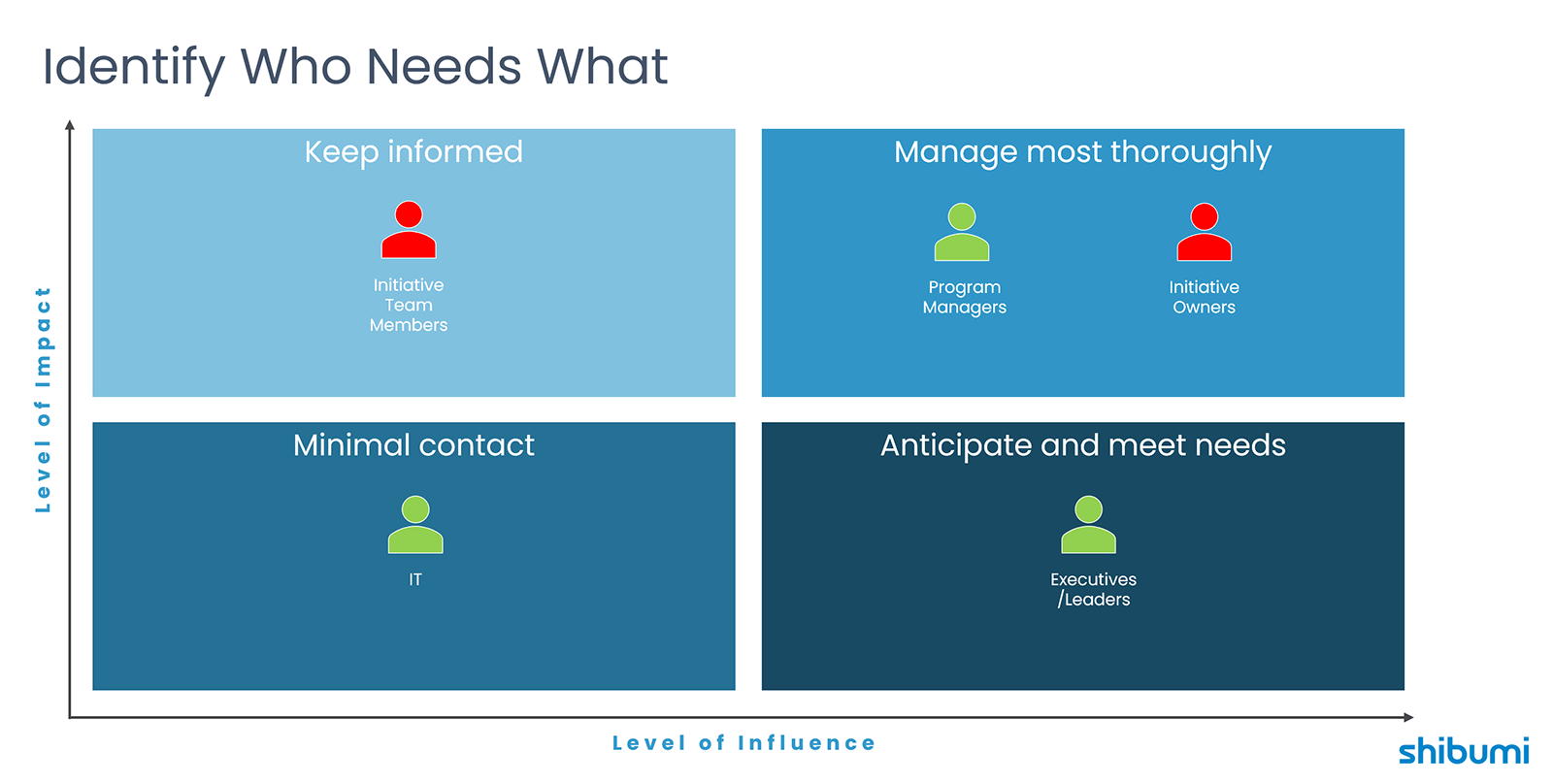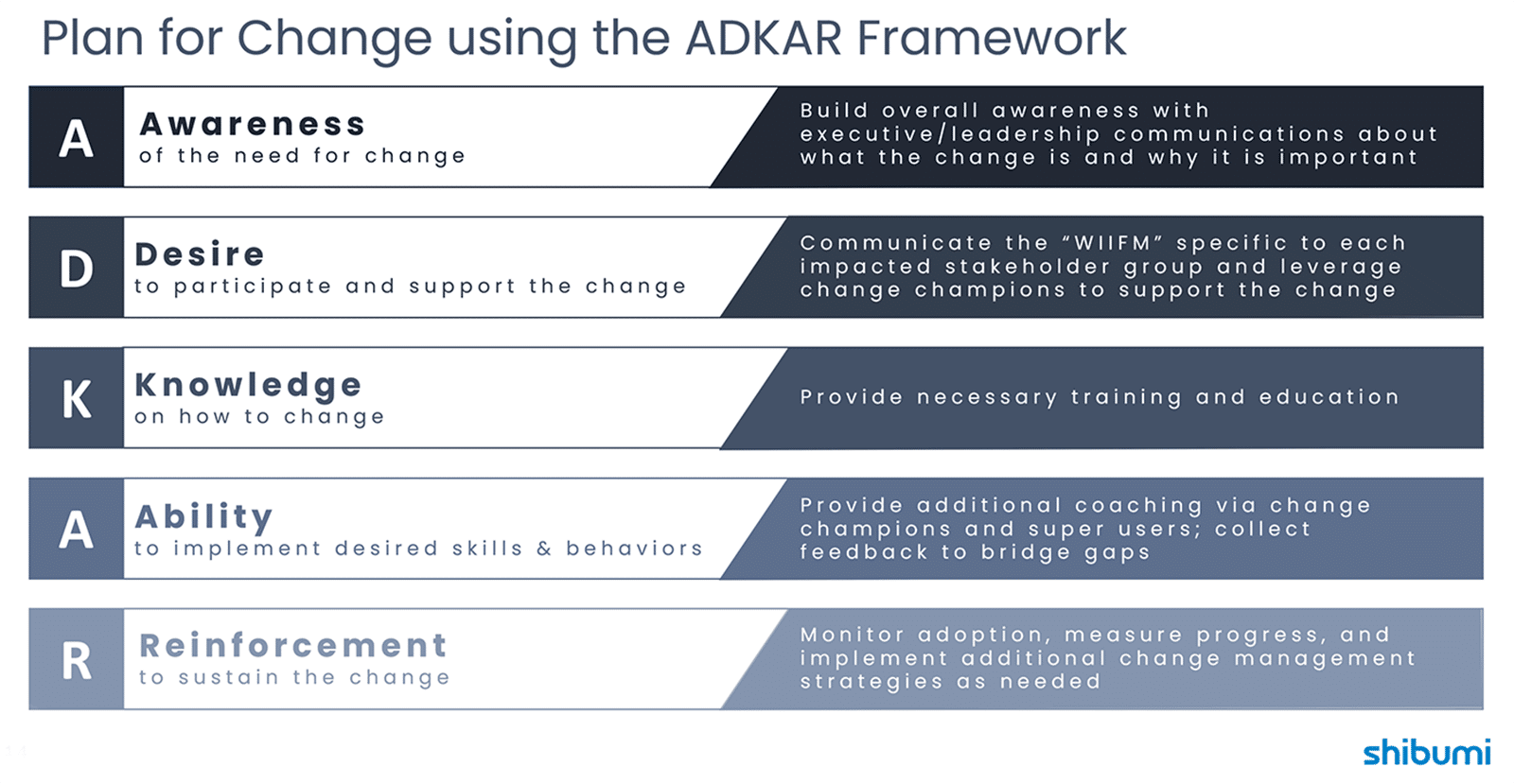In today’s world, change is a constant; organizations are continuously undergoing business transformations to reduce costs, digitize, implement new processes, etc. Although organizations often focus on how to change, they do not always focus on who needs to change. They don’t focus enough on a crucial ingredient of transformation success: Change management methodology.
According to Prosci, research consistently shows that organizations with excellent change management achieve greater success. They are 7x more likely to achieve project objectives, 4.6x more likely to stay on or ahead of schedule, and 1.4x more likely to stay on or under budget.
At Shibumi, we have seen the difference that implementing a thorough change management plan makes to the success of transformation efforts. That’s why we have developed a change management approach that we partner with our customers to execute. We use this change management methodology approach to guide our customers through their implementation of Shibumi, but anyone can apply the tools within this approach to any change management effort.
What is change management methodology?
Change management is a discipline that guides the people side of change. Any time an organization undergoes a transformation, it needs to focus on preparing individuals to successfully adopt changes in their day-to-day lives and supporting them in transitioning from their current state to a future state. Often, people hear “change management” and think of communications, but change management is about more than just communicating. Change management methodology requires assessing who is impacted by a change and to what extent, thorough planning, detailed execution, and reinforcement.
Why is Change Management Important?
Organizations often ask their transformation leaders to drive significant outcomes for the business. When leaders don’t factor change management into the transformation effort, these leaders risk incurring the costs of poorly managed change, such as timeline delays and rework. They also risk having change adopted inconsistently or incompletely, which becomes a blocker to achieving full benefit potential. With change management, transformation leaders can ensure people are on board with transformation efforts and ready to adopt changes to achieve their desired results.
Shibumi’s Approach to Change Management
Shibumi’s approach to change management is rooted in Prosci. This industry-leading change management approach provides a structured and repeatable process for enabling individuals to move through organizational change successfully. However, we also understand that every organization is unique, and no one-size-fits-all approach will work in all cases. We tailor our change management approach based on whom the change will impact, the maturity of an organization, its culture, etc. Throughout all our change management work, we also focus on driving value and strive to help organizations reach their ultimate business goals. Finally, we understand that change management never stops; it’s an ongoing process that requires monitoring and iteration.
Our change management process includes five main stages:
- Assess: This stage focuses on identifying stakeholders impacted by the change, determining the level of impact on each stakeholder group, and identifying executive stakeholder support and change champions or super users. At the end of this stage, we develop a stakeholder map and change impact assessment, which guides the rest of our change management process.
- Plan: Leveraging the information gathered in the Assess phase, we develop a comprehensive change management plan that includes communication and training elements. We also identify key adoption metrics so that we can determine the success of our change management strategy. Key outputs of this stage include a communication plan, training plan, and adoption metrics.
- Build: We then build collateral that fits the change management plan, primarily communication and training content for leaders to distribute to impacted stakeholder groups.
- Execute: We execute against the change management plan by launching communications, holding training sessions, leading SteerCo meetings, and leveraging our network of change champions to help provide coaching along the way.
- Monitor and Reinforce: After launch, we monitor usage and gather feedback to adjust our ongoing change management plans as needed. Our action plan often includes additional communications, refresher training, and in-depth user coaching. We also measure progress against the critical adoption metrics we identified during the Plan stage to understand how we have progressed in meeting change management needs.
For each stage, we will walk through some of the key activities to undertake.

Assess – Conducting a Change Impact Assessment
Within the Assess stage of our change management process, conducting a change impact assessment is the first step towards understanding the level of change individuals will be experiencing. One of the biggest challenges of implementing a change is translating organizational-level change into individual-level change. By dissecting an individual’s change journey and understanding how their day-to-day will be impacted, you can discover how to help them adopt changes.
The change impact assessment requires looking at different aspects of an individual’s job, including processes, systems/tools, roles/responsibilities, and mindsets or beliefs.
First, you need to identify the stakeholder groups impacted by the change. Often, with a Shibumi implementation, these stakeholders are program managers, initiative owners, initiative team members, and executives/leaders. Another essential aspect to consider is the level of influence of these stakeholders – are there some that have a higher level of influence over making the change successful? In addition, consider who may be a detractor vs. a promoter of the change. Influential individuals who also serve as promoters may be strong candidates for becoming change champions. Detractors are people you must pay close attention to and try to flip to a more positive outlook.
After identifying the stakeholder groups impacted by the change, you can map out how the aspects of their job will change; for example, Will they need to follow new processes? Will they need to use new systems? Will they have new roles/responsibilities they will need to fulfill? Will they need to shift their mindsets or beliefs? Mapping out these details helps determine which stakeholder groups will be highly impacted – those experiencing the most change – vs. those not as highly impacted.
Understanding the highly impacted groups vs. those who aren’t will allow you to determine how to engage with each stakeholder group. Some will need thorough engagement and management, whereas others may only need to be informed.

Plan – Planning for Change using ADKAR:
When planning for change, we use the ADKAR framework, a best practice from Prosci. ADKAR is a set of outcomes an individual needs to achieve for change to be successful: Awareness, Desire, Knowledge, Ability, and Reinforcement.

When developing your change management plan, consider each of the ADKAR elements and how you will make individuals Aware of the change, appeal to their desire to change, provide them with Knowledge and Ability to change, and Reinforce their sustainment of the change.
Each communication and training element in your change management implementation plan should align with one of these ADKAR outcomes.
Build – Developing an Asset Repository:
Once you have determined the communication and training elements that will be part of your change management plan, you can start developing those materials. At Shibumi, we have built a repository of standard communication and training materials that our customers can access to learn more about change management methodology best practices and prepare their organizational stakeholders.
Some common communication materials include executive leader emails, presentations for town hall or steering committee meetings, FAQs, and testimonials/experience stories.
Some common training materials include train-the-trainer guides, Shibumi video overviews, end-user training content, and leadership-specific training content.
Execute – Aligning Change Management Timeline to Delivery:
With your communication and training materials built, you can begin executing your change management plan. Another vital aspect is aligning your change management execution with your delivery timeline. For example, communicating and training too early is not necessarily best. Consider the “go-live” date for your solution, and work backward to determine the earliest communication point, sending out additional communications and training as go-live approaches.

Reinforce – Monitor, Reward, and Continuously Improve:
Once you are post-launch, the change still needs to be reinforced to ensure ongoing success. There are three critical elements to reinforcement:
- Monitor: put feedback loops in place to obtain feedback and track adoption KPIs
- Reward: celebrate wins, provide recognition, and share success stories
- Continuously Improve: use feedback and adoption metrics to adjust change management strategies moving forward. Put plans in place to refresh knowledge as needed.
Shibumi’s Role in Transformation Success
Transformation is difficult, but you don’t have to do it alone. Shibumi’s software can help you more easily manage all the steps of a transformation program, from planning to execution management to benefits reporting. Additionally, we can provide you with the methodology expertise and good practices that can help drive lasting change in your organization. To see how Shibumi can accelerate your transformation, request a demo today.
FAQs
FAQ 1: What is change management, and why is it important for business transformation?
Answer: Change management is a discipline that guides the people side of organizational change. It focuses on preparing individuals to successfully adopt changes in their day-to-day work and supporting them in transitioning from their current state to a future state. Change management goes beyond communications—it requires assessing who is impacted by a change, thorough planning, detailed execution, and ongoing reinforcement.
Change management is critical because organizations with excellent change management practices are significantly more successful. According to Prosci research, organizations with strong change management are 7 times more likely to achieve project objectives, 4.6 times more likely to stay on or ahead of schedule, and 1.4 times more likely to stay on or under budget. Without proper change management, transformation leaders risk timeline delays, rework, incomplete adoption, and failure to achieve the full benefit potential of their initiatives.
FAQ 2: What are the five stages of Shibumi’s change management approach?
Answer: Shibumi’s change management methodology includes five main stages based on Prosci best practices:
- Assess: Identify stakeholders impacted by the change, determine the level of impact on each stakeholder group, and identify executive support and change champions. Key outputs include a stakeholder map and change impact assessment.
- Plan: Develop a comprehensive change management plan using the ADKAR framework (Awareness, Desire, Knowledge, Ability, Reinforcement) that includes communication and training elements, along with adoption metrics.
- Build: Create communication and training materials such as executive emails, presentations, FAQs, testimonials, training guides, and video overviews.
- Execute: Launch communications, hold training sessions, lead steering committee meetings, and leverage change champions, aligning all activities with the delivery timeline.
- Monitor and Reinforce: Track usage, gather feedback, measure progress against adoption metrics, and adjust ongoing change management plans through additional communications, refresher training, and user coaching.
FAQ 3: What is a change impact assessment, and how do you conduct one?
Answer: A change impact assessment is the first step in understanding the level of change individuals will experience during a transformation. It translates organizational-level change into individual-level change by examining how different aspects of an individual’s job will be affected, including processes, systems/tools, roles/responsibilities, and mindsets or beliefs.
To conduct a change impact assessment:
- Identify stakeholder groups impacted by the change (such as program managers, initiative owners, team members, and executives)
- Determine the level of influence each stakeholder has and whether they are likely to be promoters or detractors of the change
- Map out specific changes for each stakeholder group across processes, systems, roles/responsibilities, and required mindset shifts
- Classify impact levels to determine which groups are highly impacted versus those less affected
- Create engagement strategies based on impact levels—highly impacted groups need thorough engagement and management, while others may only need to be informed
This assessment guides the rest of your change management process by helping you understand how to engage with each stakeholder group effectively.
FAQ 4: What is the ADKAR framework, and how is it used in change management planning?
Answer: ADKAR is a Prosci best practice framework that represents five outcomes an individual needs to achieve for change to be successful:
- Awareness: Understanding of the need for change
- Desire: Motivation to support and participate in the change
- Knowledge: Information about how to change
- Ability: Skills to implement required behaviors and new processes
- Reinforcement: Sustainment of the change over time
When developing your change management plan, each communication and training element should align with one of these ADKAR outcomes. For example, early communications build awareness of the change and appeal to individuals’ desire to participate. Training provides knowledge and ability to adopt new processes or systems. Post-launch activities focus on reinforcement through monitoring, rewards, and continuous improvement. This framework ensures a comprehensive approach that addresses all aspects of the individual change journey, not just information delivery.
FAQ 5: How should you align your change management timeline with project delivery?
Answer: Aligning change management execution with your delivery timeline is critical for success. Communicating and training too early is not necessarily best—timing matters.
The recommended approach is to:
- Identify your “go-live” date when the new solution, process, or system will launch
- Work backward from the go-live date to determine the earliest appropriate communication point
- Send out additional communications and training as go-live approaches, building momentum and ensuring information is fresh
- Continue post-launch reinforcement through monitoring feedback loops, tracking adoption KPIs, celebrating wins, sharing success stories, and using feedback to adjust strategies
This phased approach ensures stakeholders receive relevant information when they need it most, preventing change fatigue from premature communications while building excitement and readiness as implementation approaches. Post-launch, the focus shifts to reinforcement activities that ensure sustained adoption and continuous improvement based on real-world usage and feedback.
The information in this blog was based on the Shibumi webinar “Mastering Transformation: Essential Skills for Change Management.”

